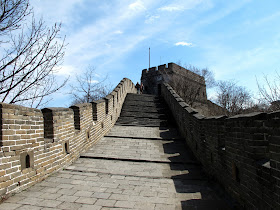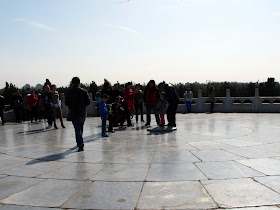Technically, this wasn't really in Beijing but it's easily done as a day trip away from Beijing so I'll leave it Beijing in the title :P
Deciding to include Great Wall in the itinerary was the easy part. Then come the second part - which section to go?
There are 4 sections that are close enough to do as a day trip from Beijing.
- Badaling (八达岭)
- Mutianyu (慕田峪)
- Huanghua Cheng (黄花城)
- Simatai (司马台)
Badaling gave me the impression that every tour group that goes to Great Wall, goes to Badaling. Don't get me wrong, by all means Badaling could be a scenic place just I am just not too keen to rub shoulders with every tour group member while I was panting like a doggie trekking up the Great Wall.
I kid you not, every pamplets we came across that goes to Great Wall, goes to this section of the Great Wall. That being said,
Little P had been to Badaling and reported that if you trek far enough, you would enjoy a little peace and break away from the crowd. After all, not all tour group gave the luxury of trekking leisurely for a couple of hours. Besides, one could combined the trip with 13 Tombs of Ming Dynasty. So there you go, don't me let scare you into avoiding Badaling :P
Thus far I have not know or heard anyone personally gone to Huanghua Cheng, so I can't comment much. As for Simatai, initially I wanted to suggest to sis to try going to Simatai but this section is probably the furthest away from Beijing, about 2 1/2 hours away. The famous trek is the one from Jinshanling to Simatai. However as of our travel, I heard it was closed for restoration, could still be close though.
In the end, we chose Mutianyu. According to this website, there is a Tourism Bus No 867 from Dongzhimen Outer that goes to Mutianyu directly at 7 am and 8.30 am. We overslept and that morning was the only morning that we woke up, got ready and left the hostel in a flash! However by the time we reached Dongzhimen Transport Hub, it was close to 8.30am, besides we weren't sure if Tourism Bus No 867 has started running as it is said to be only available from late March to November 15th. We were there in late March but how late is late?
We headed straight to
Dongzhimen Transport Hub and took
Bus 916快 (express line) towards
Huairou Bus Station (怀柔汽车站). It only cost us CNY 4.40 after 60% discount with Beijing Transportation Smart Card. We got off
Huairou Bei Dajie (怀柔北大街). As the bus traveled closer towards Huairou, there would be touts poking their head inside the bus at each bus stops and asked if any one going to Mutianyu. At one point, I almost wavered on the information I found online and wanted to get off but luckily sis was firm that we should trust the information that we found.
Right after the bus took off, we overheard other passengers (locals) talking amongst themselves that if we had got off the bus, we would've been fleeced. I came to realise that they would not voice out at that time but would probably make some comments thereafter, maybe this is to save face of the other party?
After getting off the bus, then comes the tricky part. According to this
website, to hire a mini-bus to Mutianyu. I wouldn't call that a mini-bus, it looked every inch a van, a private van too. I am terrible at haggling, we ended up paying CNY 160 for a return trip, with about 4 hours waiting time.
(We traveled on 28th March 2013). From
here, it said that one way trip with a private taxi is about CNY 60. So, this part is where you put your best haggling skills to use.
There are cable car, chair lift and toboggan services available in Mutianyu. However I think one can also walk up to the wall section from parking lot area as we walked parts of the trail down.
We had another blond moment. We were looking at a broucher clearly showing cable car but we blindly bought a return ticket for chair lift-tobaggan. Return tickets for cable car is CNY 80 according to it's website, the same for chair life-tobaggan but cableway-tobaggan only CNY 60. Chairlift and tobaggan was near to each other, but cable car station will bring you higher up comparatively.
So if you take the cable car up and down via chairlift or tobaggan, there should be more downhill parts to your walk.
Anyway, since we had paid for chairlift/tobaggan return tickets, we went up via chairlift. Umm.. that was the first time I took any chairlift. Sorry no pictures from chairlift as I was too worry to have any major movements. My camera was still in my backpack then and I didn't think it was a smart move grab it off my backpack in the midst of the chairlift.
 |
| There were snow in Mutianyu at the end of March! |
We turned right and walked till a warning sign indicating that it was dangerous to proceed further. Then we retraced our steps and walked passed the chairlift station towards the cable car station.
By this time we realised we could not use the tobaggan ticket at the cable car station. Honestly, I am a bit of a wuss and was rather scared to take the tobaggan. I blame it on my good imagination of things :P
Only at the very end of our walk we decided to go ahead for the tobaggan. I had a feeling that we were the only two that we not thrill about this tobaggan ride thing. Everybody else looked super excited and we looked worried. LOL.
Anyway, glad we did it and not forfeit the tickets. In fact at one section of it, one of the person on duty along the slide shouted to me, "太快了!" (too fast), indicating that I should slow down. You can control the speed the descent on the tobaggan yourself.
Here's a couple more photos, since I have after all, gone on a more uphill route :P
 |
| 1, 2, 3 up... again, 1, 2, 3 up. |
 |
| We were lucky, the weather was great! |
 |
| Smog? What smog? :P |
 |
| Feels like a castle eh? |
Side note: Wish there's a Kinokuniya in Melbourne!





























































